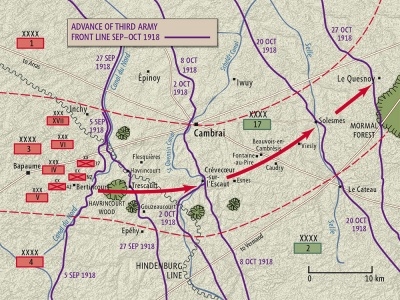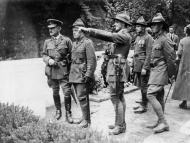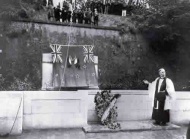Articles
New Zealand and Le Quesnoy

It was the New Zealand Division's final action of the First World War. On 4 November 1918, just a week before the Armistice was signed, New Zealand troops stormed the walled French town of Le Quesnoy. The 90 men killed were among the last of the 12,483 who fell on the Western Front.
-
Page 2 – The liberation of Le Quesnoy
The capture of the French town of Le Quesnoy by the New Zealand Division on 4 November 1918 has special significance in New Zealand's military history.
-
Page 3 – Visiting Le Quesnoy
Just 4 kilometres east of Beaudignies in northern France is Le Quesnoy. This town was in German hands for almost all of the First World War, from August 1914, until the New
-
Page 4 – Battle accounts, Lieutenant Averill
Leslie Cecil Lloyd Averill is best remembered for his exploits during the liberation of Le Quesnoy on 4 November 1918.
-
Page 5 – Battle accounts, Private Nimmo
Captain James Matheson Nimmo joined 3rd Battalion, 3rd New Zealand (Rifle) Brigade on 27 September 1918.
-
Page 6 – Further information
Further reading and links relating to Le Quesnoy
Māori units of the NZEF

More than 2000 Maori served in the Māori Contingent and Pioneer Battalion during the First World War
- Page 4 - On the Western FrontThe New Zealand Pioneer Battalion arrived in France in April 1916. It was the first unit of the New Zealand Division to move onto the bloody battlefield of the
Western Front in 1918

In 1918, a series of major German and Allied offensives broke the stalemate of trench warfare on the Western Front, resulting in the collapse of the German Army and the end of the war within the year. New Zealand units played an important part in the Allies' final push for victory.
- Page 1 - 1918: Amiens, Bapaume and victory - Western Front campaignIn 1918, a series of major German and Allied offensives broke the stalemate of trench warfare on the Western Front, resulting in the collapse of the German Army and the end of the
Armistice Day

After four terrible years, the First World War finally came to a close with the signing of an armistice between Germany and the Allied Powers on 11 November 1918. New Zealanders celebrated enthusiastically, despite having recently celebrated the surrenders of the three other Central Powers and the premature news of an armistice with Germany.
- Page 6 - New Zealanders overseasThe New Zealand Division official history records that those in France received the news of the Armistice ‘generally in a matter of fact way, totally devoid of any demonstration
Related keywords
- armistice
- WW1
- germany
- war brides
- western front
- WW1 maps
- battle of bapaume
- german army
- united states
- british army
- french army
- casualties
- weapons
- victoria cross
- WW1 stories
- prisoners of war
- letters
- war memorials
- france
- all blacks
- parades
- 1920s
- 1970s
- doctors
- artillery
- anzac day
- maps
- transport
- horses
- battle of the somme
- maori in war
- pioneer battalion
- battle of messines
- tourism
- flags
- cambridge
- window
- polderhoek attack
- funerals
- statues
- war art
- george butler
-
Main image: Advance to victory 1918 map
Map showing advance of the Third Army, including the New Zealand Division, between September and November 1918






























